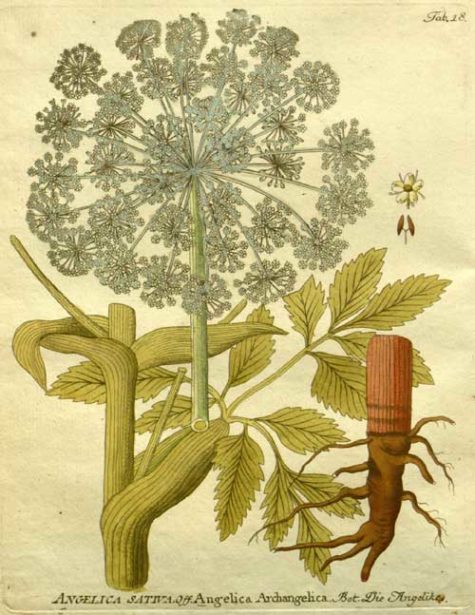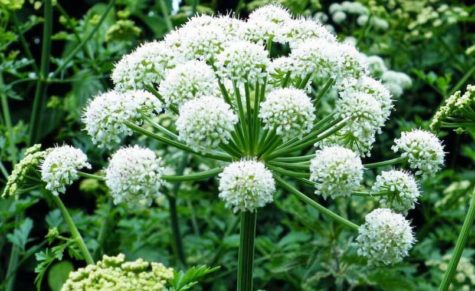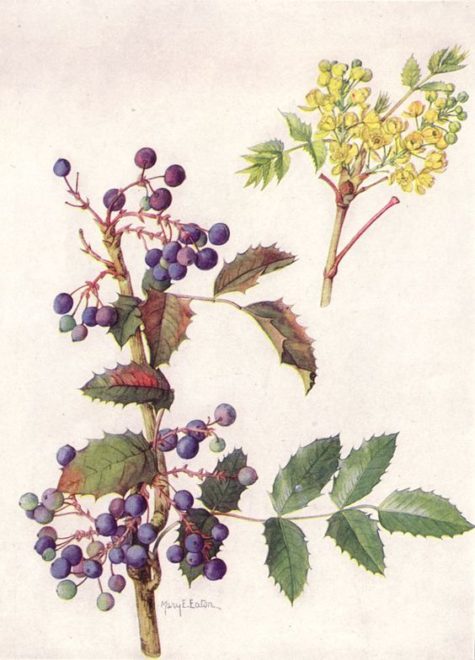Bitters
Angelica
- Scientific Name: Angelica archangelica
- Plant Family: Umbelliferae
- Parts Used: Root, seed, stems
- Actions: Alterative, Antimicrobial, Aromatic, Bitter, Carminative, Circulatory Stimulant, Diaphoretic, Diffusive, Emmenagogue, Expectorant, Grounding, Nervine
Notes: Angelica archangelica is not the same plant as Chinese Angelica (A. sinesis), often referred to as dong quai or dang gui. There are about 30 varieties of Angelica, but Angelica archangelica is the only one officially employed in medicine.
Cautions: Use care when wildcrafting, as it resembles both Queen Anne’s Lace (a benign wild carrot) and Water Hemlock (a poisonous plant).
The Basics:
Angelica is a stunning white flower that looks like a white starburst exploding across the green hillsides. One of Iceland’s most cherished herbs, it is not only beautiful, but also appreciated as a nutritious food, a liqueur and an herbal remedy. The roots and stems can be boiled or pickled and are considered a delicacy in all of Scandinavia. The stems were used to make a musical flute, as well as flavor reindeer milk or be crystallized in sugar for desserts.
Angelica is a veritable giant in the herb world. The towering plant is widely traveled and has a background rich in herbal lore. Use has been made of leaves, stems, roots, and seeds in cooking and in medicine.
Angelica is used for heartburn (dyspepsia), intestinal gas (flatulence), loss of appetite (anorexia), overnight urination (nocturia), arthritis, stroke, dementia, circulation problems, “runny nose” (respiratory catarrh), nervousness and anxiety, fever, plague, and trouble sleeping (insomnia).
According to WebMD, Angelica contains chemicals that might kill cancer cells and fungus, reduce anxiety, and settle the stomach.
Some women use Angelica to start their menstrual periods. Sometimes this is done in hopes of causing an abortion. Angelica is also used to increase urine production, improve sex drive, stimulate the production and secretion of phlegm, and kill germs.
Some people apply Angelica directly to the skin for nerve pain (neuralgia), joint pain (rheumatism), and skin disorders. In combination with other herbs, Angelica is also applied to the skin for treating premature ejaculation.
Angelica is also used as a smell in aromatherapy to reduce symptoms associated with quitting tobacco (nicotine withdrawal).
It should be noted that Angelica has a tendency to increase the sugar in the urine, so those with a tendency to diabetes should avoid it.
A strong volatile oil is present in all parts of the plant, but especially in the root, and Angelica is effective as a general tonic. Eating Angelica stalks is said to relieve flatulence and soothe “a feeble stomach.”
Drinking Angelica tea is said to promote urine and perspiration. It is also reputed to cause a strong dislike for alcohol and is sometimes used as a treatment for alcoholics.
Strain the tea to make a cool bath for tired eyes or a wash to cleanse the skin. The scented leaves are an ingredient in potpourri. Bees and wasps are attracted by the abundant nectar on Angelica flowers.
Continue reading
Oregon Grape
- Scientific Name: Berberis Aquifolium
- Common Name: Barberry
- Plant Family: Berberidaceae
- Parts Used: Rhizome and Roots, Bark, Fruits
- Actions: Alterative, cholagogue, diuretic, laxative and tonic
Description:
Several varieties of the subgenus Mahonia contribute to the drug of commerce under the name of Berberis aquifolium. It is a quickly-growing shrub about 6 feet high: the oddly compound leaves have no spine at the base; they are evergreen and shining. The flowers grow in terminal racemes, are small and yellowish-green in color, and the purple berries are three- to nine-seeded. The bark is brown on the surface and yellow beneath. The root is from 1/2 inch in diameter to 3 inches at the base of the stem, odorless, and with a bitter taste. The shrub was introduced into England from North America in 1823. It was formerly known as Mahonia aquifolia and is very hardy.
Note:It should not be used with Glycyrrhiza species (Liquorice) because this nullifies the effects of the berberine.
The Basics:
Oregon grape was often used by several native North American Indian tribes to treat loss of appetite and debility. Its current herbal use is mainly in the treatment of gastritis and general digestive weakness, to stimulate the kidney and gallbladder function and to reduce catarrhal problems. The root and root bark is alterative, blood tonic, cholagogue, diuretic, laxative and tonic. It improves the digestion and absorption and is taken internally in the treatment of psoriasis, syphilis, haemorrhages, stomach complaints and impure blood conditions. Externally, it has been used as a gargle for sore throats and as a wash for blurry or bloodshot eyes.
The blue fruits are tart and improve after frost. They are often gathered for jelly or wine. Used to treat a wide variety of ailments, Oregon Grape species contain the extremely potent alkaloid, berberine, (also found in goldenseal) which is antiseptic and stimulates the liver and spleen.
The fruit is an excellent gentle and safe laxative. Berberine, universally present in rhizomes of Mahonia species, has marked antibacterial effects and is used as a bitter tonic. Since it is not appreciably absorbed by the body, it is used orally in the treatment of various enteric infections, especially bacterial dysentery.
Berberine has also shown anti-tumor activity.
It is one of the best alterative blood purifiers and liver stimulants. Uses for the Oregon Grape Root include weak digestion, flatulence, jaundice, blood impurities, and as a general tonic to the whole system.
A decoction (instructions below) will be found to be a wonderful blood purifier and will restore health to many who are suffering from a sluggish liver, weak stomach, indigestion, and sallow skin.
Years ago, it was given to children, and said to create appetite and promote digestion, and increase strength and vitality. The current medical thinking is that it is not safe for children, especially infants, or pregnant or nursing women. (see information at the bottom of the post)
Continue reading
Rennie Luttrull: queen-annes-lace-seeds
Rosanna: Spignel aka Bald Money
Annamarie Squatrito: Fumitory
EILEEN Klinghagen: Pumpkin
Mahmudul Hasan: Celery




